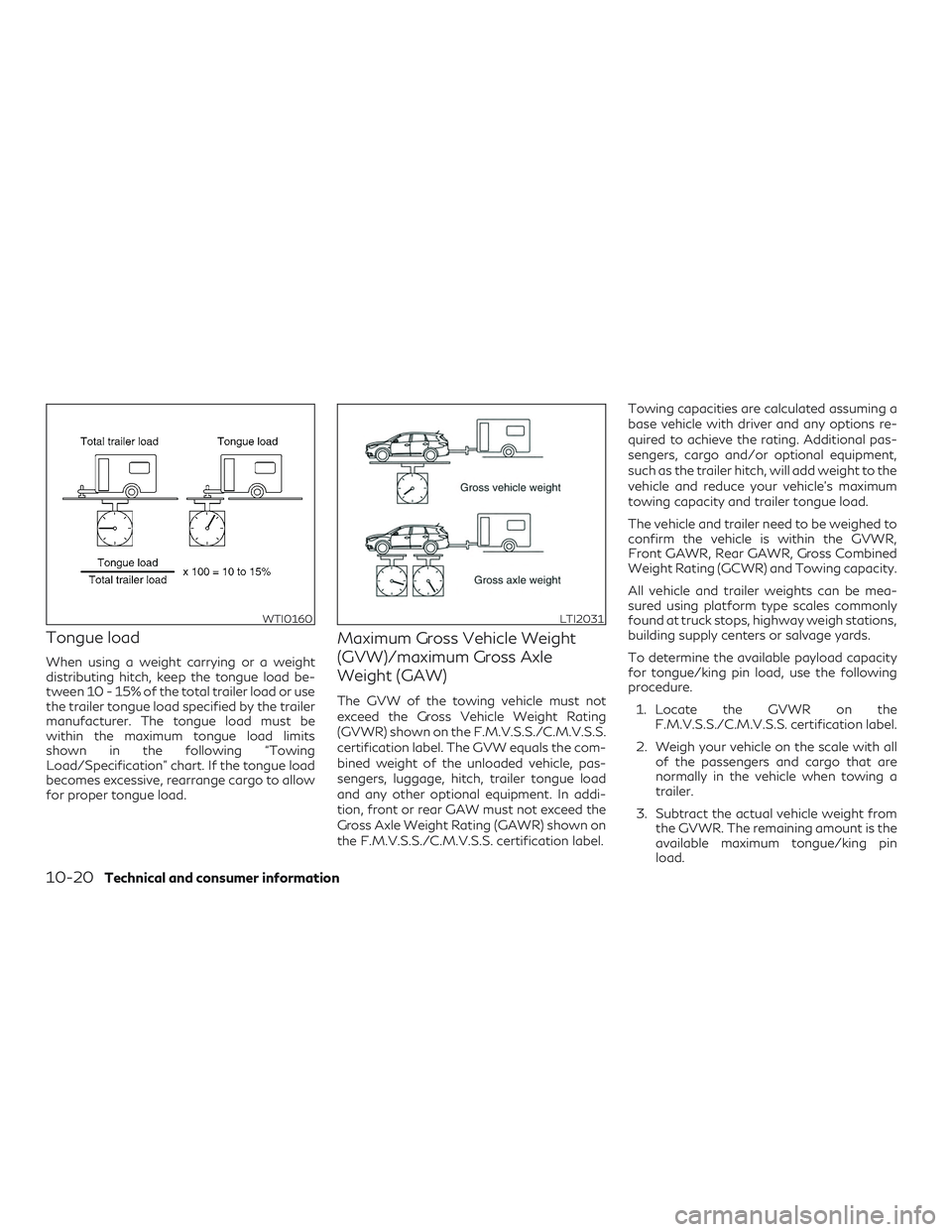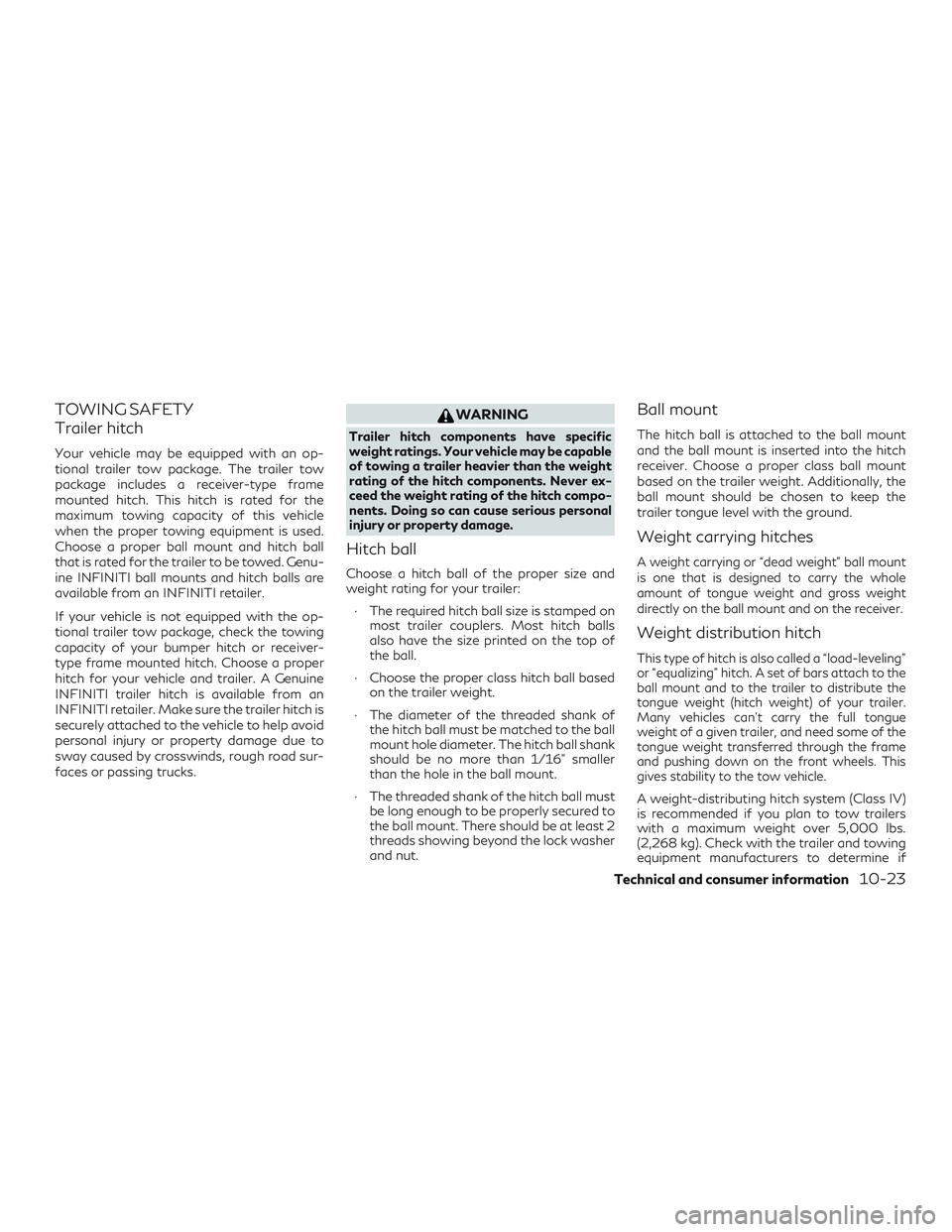load capacity INFINITI QX50 2020 User Guide
[x] Cancel search | Manufacturer: INFINITI, Model Year: 2020, Model line: QX50, Model: INFINITI QX50 2020Pages: 572, PDF Size: 7.29 MB
Page 540 of 572

Tow Hitch Receiver (with Tow Package)
WARNING
Overloading or improper loading of a trailer
and its cargo can adversely affect vehicle
handling, braking and performance and
may lead to accidents.
CAUTION
∙ Do not tow a trailer or haul a heavy loadfor the first 500 miles (805 km). Your
engine, axle or other parts could be
damaged. ∙ For the first 500 miles (805 km) that you
tow a trailer, do not drive over 50 mph
(80 km/h) and do not make starts at full
throttle. This helps the engine and other
parts of your vehicle wear in at the
heavier loads.
NOTE:
Tow hitches are available as an accessory for
this vehicle. If a tow hitch is installed, the
liftgate electronic control unit (ECU) needs
to be replaced with an ECU programmed
with towing logic for the Motion-Activated
Liftgate to function properly.
Your new vehicle was designed to be used
primarily to carry passengers and cargo. Re-
member that towing a trailer places addi-
tional loads on your vehicle’s engine, drive
train, steering, braking and other systems.
An INFINITI Towing Guide (U.S. only) is avail-
able on the website at www.InfinitiUSA.com.
This guide includes information on trailer
towing capability and the special equipment
required for proper towing. Lifestyle Receiver (without Tow Package)
WARNING
The Lifestyle Receiver cannot be used for
towing a trailer. Only use the Lifestyle Re-
ceiver for receiver mounted accessories
that meet the below requirements.
∙ The maximum allowable load is 300 lbs.
(136 kg) including the weight of the in-
stalled accessory carrier.
∙ Do not exceed allowable cargo weight capacity of your vehicle.
Failure to use the Lifestyle Receiver as in-
tended can result in serious injury or death.
LTI2339LTI2338
TOWING A TRAILER
10-18Technical and consumer information
Page 542 of 572

Tongue load
When using a weight carrying or a weight
distributing hitch, keep the tongue load be-
tween 10 - 15% of the total trailer load or use
the trailer tongue load specified by the trailer
manufacturer. The tongue load must be
within the maximum tongue load limits
shown in the following “Towing
Load/Specification” chart. If the tongue load
becomes excessive, rearrange cargo to allow
for proper tongue load.
Maximum Gross Vehicle Weight
(GVW)/maximum Gross Axle
Weight (GAW)
The GVW of the towing vehicle must not
exceed the Gross Vehicle Weight Rating
(GVWR) shown on the F.M.V.S.S./C.M.V.S.S.
certification label. The GVW equals the com-
bined weight of the unloaded vehicle, pas-
sengers, luggage, hitch, trailer tongue load
and any other optional equipment. In addi-
tion, front or rear GAW must not exceed the
Gross Axle Weight Rating (GAWR) shown on
the F.M.V.S.S./C.M.V.S.S. certification label.Towing capacities are calculated assuming a
base vehicle with driver and any options re-
quired to achieve the rating. Additional pas-
sengers, cargo and/or optional equipment,
such as the trailer hitch, will add weight to the
vehicle and reduce your vehicle’s maximum
towing capacity and trailer tongue load.
The vehicle and trailer need to be weighed to
confirm the vehicle is within the GVWR,
Front GAWR, Rear GAWR, Gross Combined
Weight Rating (GCWR) and Towing capacity.
All vehicle and trailer weights can be mea-
sured using platform type scales commonly
found at truck stops, highway weigh stations,
building supply centers or salvage yards.
To determine the available payload capacity
for tongue/king pin load, use the following
procedure.
1. Locate the GVWR on the F.M.V.S.S./C.M.V.S.S. certification label.
2. Weigh your vehicle on the scale with all of the passengers and cargo that are
normally in the vehicle when towing a
trailer.
3. Subtract the actual vehicle weight from the GVWR. The remaining amount is the
available maximum tongue/king pin
load.
WTI0160LTI2031
10-20Technical and consumer information
Page 543 of 572

To determine the available towing capacity,
use the following procedure.1. Find the GCWR for your vehicle on the "Towing Load/Specification" chart
found in this section.
2. Subtract the actual vehicle weight from the GCWR. The remaining amount is the
available maximum towing capacity.
To determine the Gross Trailer Weight, weigh
your trailer on a scale with all equipment and
cargo, that are normally in the trailer when it
is towed. Make sure the Gross trailer weight
is not more than the Gross Trailer Weight
Rating shown on the trailer and is not more
than the calculated available maximum tow-
ing capacity.
Also weigh the front and rear axles on the
scale to make sure the Front Gross Axle
Weight and Rear Gross Axle Weight are not
more than Front Gross Axle Weight and Rear
Gross Axle Weight on the
F.M.V.S.S./C.M.V.S.S. certification label. The
cargo in the trailer and vehicle may need to be
moved or removed to meet the specified rat-
ings. Example:
∙ Gross Vehicle Weight (GVW) as weighed on a scale - including passengers, cargo
and hitch - 4,650 lbs. (2,109 kg).
∙ Gross Vehicle Weight Rating (GVWR) from F.M.V.S.S./C.M.V.S.S. certification
label - 4,916 lbs. (2,230 kg).
∙ Gross Combined Weight Rating (GCWR) from “Towing Load/Specification" chart
- 7,320 lbs. (3,320 kg).
∙ Maximum Trailer towing capacity from “Towing Load/Specification" chart -
3,000 lbs. (1,361 kg).4,916 lbs. (2,230 kg) GVWR
– 4,650 lbs. (2,109 kg) GVW
= 266 lbs. (121 kg) Available for tongue weight
7,320 lbs. (3,320 kg) GCWR
– 4,650 lbs. (2,109 kg) GVW
= 2,670 lbs. (1,211 kg) Capacity available for towing
266 lbs. (121 kg) Available tongue weight
= 2,670 lbs. (1,211 kg) Available capacity
= 10 % tongue weight
The available towing capacity may be less
than the maximum towing capacity due to
the passenger and cargo load in the vehicle.
Remember to keep trailer tongue weight be-
tween 10 - 15% of the trailer weight or within
the trailer tongue load specification recom-
mended by the trailer manufacturer. If the
tongue load becomes excessive, rearrange
the cargo to obtain the proper tongue load.
Do not exceed the maximum tongue weight
specification shown in the “Towing
Load/Specification” chart even if the calcu-
Technical and consumer information10-21
Page 544 of 572

lated available tongue weight is greater than
15%. If the calculated tongue weight is less
than 10%, reduce the total trailer weight to
match the available tongue weight.
Always verify that available capacities are
within the required ratings.TOWING LOAD/SPECIFICATION
WARNING
The towing capacities provided in this
manual are for general reference only. The
safe towing capacity of your vehicle is af-
fected by dealer and factory installed op-
tions and passenger and cargo loads. You
must weigh the vehicle and trailer as de-
scribed in this manual to determine the ac-
tual vehicle towing capacity. Do not exceed
the published maximum towing capacity or
the GCWR or the GVWR shown on the
FMVSS/CMVSS label. Doing so can result
in an accident causing serious injury or
property damage.
TOWING LOAD/SPECIFICATION CHART
Axle type AWD2WD/AWD
With Tow Package Without Tow Package
Maximum Towing Capacity*1 3,000 lbs. (1,361 kg)Do not tow with your vehicle
Maximum Tongue Load 300 lbs. (136 kg)Do not tow with your vehicle
Maximum Gross Combined Weight Rating 7,320 lbs. (3,320 kg)Do not tow with your vehicle
*1: The towing capacity values are calculated assuming a base vehicle with driver and any options required to achieve the rating. Additional
passengers, cargo and/or optional equipment will add weight to the vehicle and reduce your vehicle’s maximum towing capacity.
10-22Technical and consumer information
Page 545 of 572

TOWING SAFETY
Trailer hitch
Your vehicle may be equipped with an op-
tional trailer tow package. The trailer tow
package includes a receiver-type frame
mounted hitch. This hitch is rated for the
maximum towing capacity of this vehicle
when the proper towing equipment is used.
Choose a proper ball mount and hitch ball
that is rated for the trailer to be towed. Genu-
ine INFINITI ball mounts and hitch balls are
available from an INFINITI retailer.
If your vehicle is not equipped with the op-
tional trailer tow package, check the towing
capacity of your bumper hitch or receiver-
type frame mounted hitch. Choose a proper
hitch for your vehicle and trailer. A Genuine
INFINITI trailer hitch is available from an
INFINITI retailer. Make sure the trailer hitch is
securely attached to the vehicle to help avoid
personal injury or property damage due to
sway caused by crosswinds, rough road sur-
faces or passing trucks.
WARNING
Trailer hitch components have specific
weight ratings. Your vehicle may be capable
of towing a trailer heavier than the weight
rating of the hitch components. Never ex-
ceed the weight rating of the hitch compo-
nents. Doing so can cause serious personal
injury or property damage.
Hitch ball
Choose a hitch ball of the proper size and
weight rating for your trailer:∙ The required hitch ball size is stamped on most trailer couplers. Most hitch balls
also have the size printed on the top of
the ball.
∙ Choose the proper class hitch ball based on the trailer weight.
∙ The diameter of the threaded shank of the hitch ball must be matched to the ball
mount hole diameter. The hitch ball shank
should be no more than 1/16” smaller
than the hole in the ball mount.
∙ The threaded shank of the hitch ball must be long enough to be properly secured to
the ball mount. There should be at least 2
threads showing beyond the lock washer
and nut.
Ball mount
The hitch ball is attached to the ball mount
and the ball mount is inserted into the hitch
receiver. Choose a proper class ball mount
based on the trailer weight. Additionally, the
ball mount should be chosen to keep the
trailer tongue level with the ground.
Weight carrying hitches
A weight carrying or “dead weight” ball mount
is one that is designed to carry the whole
amount of tongue weight and gross weight
directly on the ball mount and on the receiver.
Weight distribution hitch
This type of hitch is also called a “load-leveling”
or “equalizing” hitch. A set of bars attach to the
ball mount and to the trailer to distribute the
tongue weight (hitch weight) of your trailer.
Many vehicles can’t carry the full tongue
weight of a given trailer, and need some of the
tongue weight transferred through the frame
and pushing down on the front wheels. This
gives stability to the tow vehicle.
A weight-distributing hitch system (Class IV)
is recommended if you plan to tow trailers
with a maximum weight over 5,000 lbs.
(2,268 kg). Check with the trailer and towing
equipment manufacturers to determine if
Technical and consumer information10-23